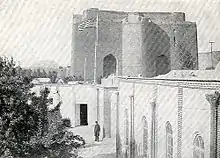Howard Baskerville
Howard Conklin Baskerville (10 April 1885 – 19 April 1909) was an American teacher in the American Memorial School in Tabriz (a Presbyterian mission school in Tabriz, Iran)
Howard Baskerville | |
|---|---|
 Howard Baskerville | |
| Born | Howard Conklin Baskerville 10 April 1885 |
| Died | 19 April 1909 (aged 24) |
| Burial place | Tabriz, East Azerbaijan, Iran |
| Nationality | American |
| Parent(s) | Henry Embry Coleman Baskerville Emma R. Baskerville[1] |
Background
Baskerville was born in North Platte, Nebraska, and was raised in the Black Hills. Both his father and grandfather were Presbyterian ministers. He graduated in 1907 from Princeton University, where, in addition to studying religion and boxing, he took two courses with Woodrow Wilson (Jurisprudence and Constitutional Government).[2]
Career

In the fall of 1907, Baskerville came to Iran as a missionary. He took a position in the American Memorial School, a missionary school, in Tabriz. There he taught English, history, and geometry to mixed classes of boys and girls and also served as tennis coach and riding instructor. He directed a student production of The Merchant of Venice.
In the spring of 1909, during the Constitutional Revolution of Iran, he decided to raise a volunteer force to defend constitutional democracy. Despite attempts to discourage him by the American consul in Tabriz, William F. Doty, he led about a hundred volunteers attempting to help defend the besieged city against Qajar royalist troops fighting for Mohammad Ali Shah.
Death
Baskerville was shot and killed by a sniper while leading a group of student soldiers to break the siege.[3] He was 24 years old.

He has been quoted as saying, "The only difference between me and these people is my place of birth, and this is not a big difference." Baskerville's funeral was attended by thousands, where he was eulogized by Iranian patriots. He was buried in the Christian Armenian cemetery in Tabriz. Shortly after Baskerville's death, Tabriz siege was lifted by Russian troops by international convention.[4] Tabriz events led to the dethronement of the Nasereddin Shah and re-establisment of the Majlis.
In a speech at the funeral ceremony, Hassan Taqizadeh described him as:[5]
- "Young America, in the person of young Baskerville, gave this sacrifice to the young Constitution of Iran,..."
A Persian carpet with his picture woven on it was made by the carpet weavers of Tabriz and meant to be sent to Baskerville's mother in America (but was never sent) in recognition of his courage and sacrifice.
Legacy

Baskerville always remained an exception in relation between Iran and United States even when the relationship was at its worst stage. In December 1979, during the hostage crisis a group of American clergymen visited Tehran to soften the relationship. During the group's visit of a mosque, a middle-aged Iranian got up and asked: "Where are the American Baskervilles of today?"[6]
Many Iranian nationalists revere Baskerville. Schools and streets in Iran have been named for him.[7] People visit his grave freely. A "mysterious admirer" is reported "regularly" to place "yellow roses" on his grave.[8]
There is a bust of him in Tabriz's Constitution House bearing the legend "Howard C. Baskerville— Patriot and Maker of History".
See also
References
- Howard C Baskerville
- Kinzer, Stephen (2010). Reset: Iran, Turkey, and America's Future. New York: Times Books. p. 2. ISBN 978-0-8050-9127-4.
- Calafi, Farnaz; Dadpay, Ali; Mashayekh, Pouyan (18 April 2009). "Iran's Yankee Hero". New York Times.
- Clark, James D. (2006). "Constitutionalists and Cossacks: The Constitutional Movement and Russian Intervention in Tabriz, 1907-11". Iranian Studies. 39 (2): 199–225. ISSN 0021-0862. Retrieved 27 January 2021.
- Stephen Kinzer, Reset: Iran, Turkey, and America's Future, Times Books, 2010.
- https://www.webcitation.org/6fz89gK9P?url=https://www.princeton.edu/paw/archive_new/PAW06-07/13-0509/features1_heroiran.html
- Kinzer (2010), p. 6.
- Molavi, Afshin (2005). The Soul of Iran. New York: Norton. p. 218. ISBN 0-393-32597-0.
Further reading
- Lorentz, John H. (1995). Historical Dictionary of Iran. Lanham, Maryland: Scarecrow Press. ISBN 0-8108-2994-0.
- Maalouf, Amin (1998). Samarkand: A Novel (translated from French by Russell Harris). New York: Interlink Books. ISBN 1-56656-293-7.
External links
| Wikimedia Commons has media related to Howard Baskerville. |
- A very detailed discussion of his life and efforts from Princeton University:
- Princeton.edu
- Tribute to Howard Baskerville (Persia's American Hero) on YouTube
- Images of Revolution. The Constitutionalist Revolution: 1906-1909.
- Article on Iranian.com
- "I am Persia's" - American wife of a missionary in Tabriz writes on Baskerville's death.
- Image of a carpet made by people of Tabriz for his mother as a sign of appreciation
- NYTimes profile
